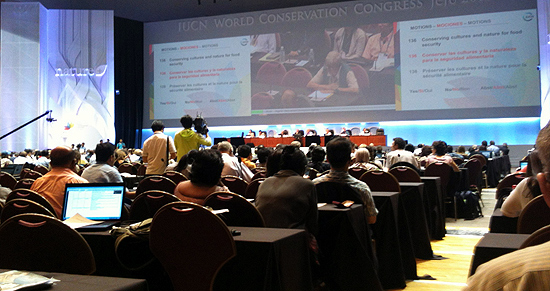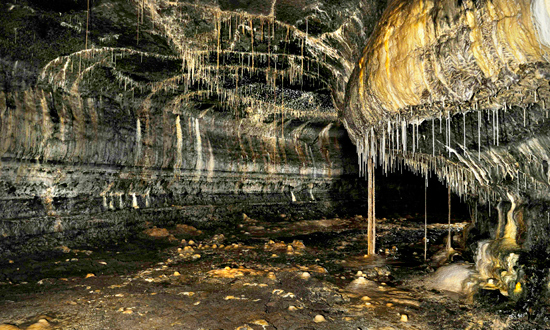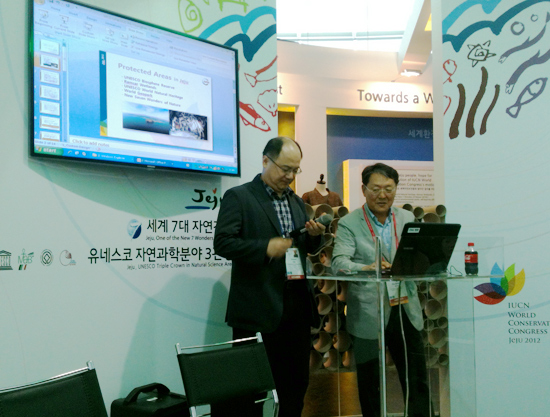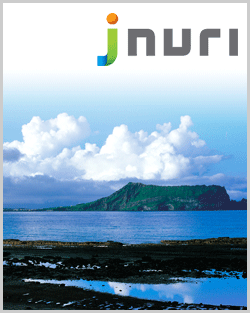
동굴천장에 나무뿌리가 매달려 있는 어두운 동굴 사진들이 스크린에 나타났다. 이어 바위에서 자라고 있는 나무사진들이 나타났다. 사진들은 수천 년 동안 감춰졌던 곳을 한 탐험가가 발견하는 모험 영화의 한 장면을 보여주는 듯 했다.
이 두 장면들은 제주특별자치도가 WCC에서 제주 자연보호의 지지를 얻기 위해 이 분야의 저명한 전문가들이 정리한 내용들이다.

제주시 구좌읍 김녕리 용천동굴 100m 안에서 자라고 있는 식물 DNA 분석을 하고 있는 김상태 교수 등은 전문가와 탐험가로 일했다. 이 동굴은 2006년 전봇대를 설치하는 과정에서 발견됐고, 자연 보물상자와도 같았다. 김 교수는 어떻게 이 식물들의 뿌리가 동굴을 통과했으며 동굴구조에 어떤 영향을 끼칠 건지를 질문했다. 이 뿌리들은 살아있는가? 아님 죽어있는가? 이 뿌리들이 동굴을 붕괴시킬 것인가? 김 교수가 만든 DNA 바코드 시스템이 이 모든 것을 분류했다.
사람들이 더 이상 이 동굴 위에 있는 땅을 사용하지 않아 식물들이 이렇게 뿌리를 내리게 됐다. 2007년에 찍은 것과 2010년 찍은 두 사진을 비교해 보면, 2007년에 찍은 사진은 거의 아무 뿌리도 없다. 2010년 사진은 정말 많은 뿌리들이 있었다.

김 교수는 각각의 식물이 자라는 형태를 연구하기 위해 염색을 포함한 다양한 실험들을 계속하기를 원한다. 이 정보는 항상 멋있는 지하호주로 우리를 유혹하는 용천동굴의 멋진 사진들과는 다른 흥미로운 면을 보여준다. 김 교수에 따르면 50명의 사람들만 이 곳을 방문했다고 한다. 이 동굴은 그 만큼 붕괴되기 쉽기 때문이다.
50명 이상의 사람이 방문한 곳은 제주 곶자왈이다. 곶자왈은 109.7k㎢ 혹은 제주전체의 6%를 차지한다. 동굴과는 다르게 곶자왈은 우리가 좀 더 즐길 수 있는 곳인 듯하다. 1.5㎢가 올해 말 서귀포 공원으로 지정될 예정이다.
제주 파빌리언은 단지 제주 자연 맛보기에 불과했다. 하지만 제주도민들은 그들이 원할 때 이 경이로운 자연을 언제든지 탐험할 수 있다.
■칼럼
제주의 일상생활과 WCC
당신이 키가 크더라도 WCC에서는 작다는 느낌을 쉽게 받을 수 있다. 전 세계에서 온 수천 명의 전문가들 사이에 보통 평범한 제주도민. 그 전문가들은 대단하면서도 겸손하기까지 하다. 캐리비안의 산호 전문가에서부터 음식공급 전문가, 오지에 사는 야생동물 보호 전문가들까지.
WCC는 10일 동안에 거쳐 거대한 캔버스를 만들어 냈다. 그러나 많은 제주도민들은 월요일부터 금요일까지 해야 하는 직업이 있으며 많은 이들은 우리의 일상생활을 어떻게 적용할지 의아스러워 하기도 했다. 특히 출근할 때 도남 5거리를 안전하게 건너는 것이 중요한 성공이고, 아이를 학교에 데려다 주고 집에 와서 요리하고 저녁이면 다시 지저분해질 아파트를 청소하는 것이 중요한 일인 이런 일상생활들 말이다.
우리가 직접 만질 수 있고 느낄 수 있는 성과들을 위해서 우리는 우리지역에 집중해야 한다. WCC에서 하논분화구를 보호하기로 결의안이 통과된 것을 기억하자. 더욱 중요한 것은 제주해녀가 WCC로 인해 많은 후원을 받게 됐다는 것이다. 또 우리에게 제주시와 서귀포시에서 멀지 않은 곳에 있는 곶자왈의 보호에 대해서 알려준 제주 파빌리언 이벤트도 기억해야 한다.
특히 곶자왈 공원이 완성이 되면, 우리에게는 탐사할 더 많은 곳이 생기게 된다. 그리고 우리 같은 평범한 사람들이 볼 수 없는 용천굴도 있다. 단지 사진과 정보들이 우리가 걷고 운전하고 다니는 도로 아래에 이 동굴이 있음을 알려준다.
이제 WCC 참가자들은 떠났고 우리는 WCC가 무엇을 남겼는지 살펴봐야 한다. WCC는 성공적인 결과를 낳았는가 아니면 돈만 많이 든 쓸모없는 흰 코끼리가 됐는가? WCC가 제주에 대한 긍정적인 홍보를 했지만, 제주도민의 전부터 다뤄 오던 이슈들은 아직도 그대로 있다. 일상생활의 작은 투쟁들과 성공들은 계속 진행될 것이다.
Jeju's WCC pavilion shares fascinating local content with the world
A photograph showing a darkened cave with roots dangling from the roof scrolled across the screen.
Later more photographs uncovered large boulders strewn with old trees and green vegetative growth. These photographs wouldn't have been out of place in an adventure movie in which the explorer finds undisturbed land for the first time in thousands of years.
Both scenes, however, were just two of the many informative pavilion sessions organized by the Jeju-Self Governing Province throughout the World Conservation Congress. Pavillion sessions in which experts from their respective fields came out to build support for nature-protecting, Jeju-proposed, motions.
Experts and explorers such as Kim Sang-tae, who is conducting a DNA analysis on the vegetation growing within a hundred meter radius of Gimnyoung's Youngcheon Cave. The cave was first discovered during the installation of an electricity pole in 2006 and is a natural treasure box. Some of the questions Kim is asking include how the vegetation's roots penetrate and affect the cave's structure. Are the roots alive? Are the roots dead? Will they lead to cave-ins? A DNA bar-coding system he created catalogues this all.
Curiously these roots are a result of prohibiting land use above the cave's route. A comparison of two photographs illustrates this point. One from 2007 shows nearly nothing. 2010 shows so many.
In the future Kim hopes to use dye to identify individual root growth patterns and better understand the topic. The information on Youngcheon Cave proved most interesting as the cave is usually only glimpsed through glossy photographs teasing us with the underground lake. It was good to see in an ugly glory. It is a place, according to Kim, only 50 people in the whole world have visited. The cave is just that fragile.
A place where more than 50 people have visited is Jeju's Gotjawal. It stretches over 109.87 square kilometers or some 6 per cent of the islands surface. The Gotjawal Trust of Jeju presented their case for increased protection. Since 2007 the trust has worked to purchase private land and make it public.
Unlike the cave system we will be able to enjoy more of the Gotjawal in the future. There are plans to open 1.5 square kilometers of land as a park in Seogwipo from later this year.
For the world it was just a taste of Jeju's natural wonder. A natural wonder most of which the Jeju resident gets to explore as they want.
■Column
Jeju's everyday life and the WCC
When you're tall it's easy to feel so small in so many ways at the World Conservation Congress.
Just one small Jeju resident in among thousands of people from all over the world each with their own area of expertise. An expertise that is amazing and humbling at the same time. From experts on coral in the Carribean to experts on food supply and protecting the world's wildlife in far-flung corners. The WCC creates a huge canvas to cross in ten days. However many Jeju residents have a day job to look after from Monday to Friday and may wonder how we can relate it to our everyday lives. Especially when safely crossing Donam's five-way intersection on our commute is considered a major success. Or taking the children to school only to return home to cook and clean in an apartment that'll be messy again once the evening arrives. We should look local to the successes we can, in most cases, reach out and touch ourselves. Consider the WCC motion that will protect the Hanon Crater. More importantly, Jeju's haenyo will also have greater support because of the WCC. These are real people with real families right here on the island and will be assisted in their everyday lives. We should also consider the Jeju pavillion events which informed us about the protection of the Gotjawal we have a short drive from either Jeju City or Seogwipo. A real joy to discover, especially when the Gotjawal park is finished. Then we have Youngcheon Cave which people like you and I can't see because of its fragility. Yet the information and photographs let us know that it is right their beneath the ground we walk on and the roads we drive on.
Now the WCC participants have left the island we can look at what is left behind.Will the WCC and its aftermath be a success or white elephant in Jeju's future? Perhaps it's too early to say. However for all the positive promotion surrounding the WCC, the issues Jeju's residents were dealing with before are still with us now. Life's small daily struggles and successes for Jeju residents go on.
| ☞짐 선더스(Jim saunders)는?
대학을 졸업하고 넓은 세상을 알고자 세계여행을 기획, 첫 도착지로 대한민국을 선택했다. 그런데 이젠 세계여행을 접고 제주사람으로 살아가려 하고 있다. 제주의 자연이 너무도 좋고, 제주의 문화가 마음에 쏙 들어서다. 그래서 지금은 한국사회와 한국어에 대한 공부를 하고 있다. 또 한국사회의 일원으로 당당히 참여하고 싶어 한다.
2008년부터 제주에서 살면서 외국인들에게 제주에 대한 이해를 높이기 위해 ‘제주라이프’(Jeju Life)라는 영어잡지를 매월 발간하기도 했다. 지금도 제주의 곳곳을 다니며 제주의 숨겨진 이야기를 홈페이지(www.jimsaunders.info)를 통해 알리며 제주의 전령사 역할을 톡톡히 하고 있다.
|









































